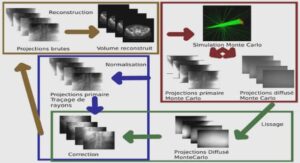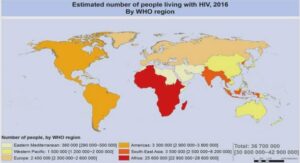L’étude de la fidélité au site chez le caribou forestier (Rangifer tarandus caribou)
L’écotype forestier du caribou des bois occupe de grands domaines vitaux et une bonne partie de son aire de répartition est soumise à une activité humaine intensive. Il est par conséquent des plus pertinent de s’attarder à la fidélité au site du caribou forestier puisque ce comportement joue un rôle potentiellement important dans la dynamique des populations du caribou ainsi que pour sa conservation. Le comportement de fidélité au site a été observé chez le caribou forestier mais les observations diffèrent en fonction des périodes de l’année et entre les diverses populations (Rettie et Messier, 2001; Ferguson et Elkie, 2004). Par exemple, certaines populations démontrent une fidélité inter-annuelle plus importante durant l’été qu’au cours de l’ hiver (Schaefer et al., 2000; Ferguson et Elkie, 2004), tandis que pour d’ autres populations aucune différence saisonnière n’ est observée (Rettie et Messier, 2001). Le caribou des bois est une sous-espèce composée de trois écotypes au Québec: le toundrique, le montagnard et le forestier. La conservation de l’écotype forestier est une problématique des plus actuelle et préoccupante. Au cours du vingtième siècle, les populations de caribou forestier ont connu un important déclin en terme d’abondance ainsi qu’une diminution de leur aire de répartition à travers toute l’ Amérique du Nord (Courtois et al. , 2003b; Schaefer, 2003). Le caribou forestier est toujours en difficulté dans l’ ensemble de son aire de répartition (Rettie et Messier, 1998 ; Courtois et al., 2003 a; Wittmer et al. , 2005a) et cet écotype est désigné menacé au Canada depuis 2002 (COSEWIC, 2006) et vulnérable au Québec depuis 2005 (MRNF, 2007). La limite méridionale de son aire de répartition au Québec a considérablement régressé vers le nord, se situant maintenant près du 4ge parallèle alors qu’elle rejoignait jadis le nord des États- Unis (Sebbane et al., 2002; Courtois et al., 2003b).
À l’origine, le déclin du caribou forestier aurait été causé essentiellement par la chasse et la prédation (Bergerud, 1974; Rettie et Messier, 1998), tandis qu ‘ aujourd ‘ hui, les modifications de son habitat par les perturbations anthropiques, qui favorisent la prédation, seraient le facteur le plus important (Heard et Vagt, 1998 ; Rettie et Messier, 1998; Schaefer, 2003 ; Wittmer et al., 2005b; Vors et al. , 2007). Le caribou forestier est en effet très sensible aux perturbations anthropiques présentes dans son habitat qui découlent majoritairement de l’exploitation forestière. Il a été démontré que les pratiques forestières actuelles modifient de façon significative le faciès de la forêt boréale (Boucher et al. , 2006). D’importants changements sont ainsi observés dans la composition, la structure et la dynamique des communautés végétales et animales (Primack, 1998; Haila, 1999). Les forêts conifériennes matures et surannées se raréfient tandis que les peuplements feuillus et les jeunes stades de succession sont de plus en plus présents dans le paysage (Andersson et Ostlund, 2004; Boucher et al. , 2006).
L’ exploitation forestière entraîne également la construction d’ un important réseau routier facilitant l’ accès au territoire et le développement d’ infrastructures, qui par le fait même augmentent le dérangement (Rempel et al., 1997; Trombulak et Frissell, 2000; Sebbane et al., 2002; Courtois et al., 2003a). Les modifications de l’ habitat suivant les coupes forestières peuvent être favorables à certaines espèces (ex. original (Alces alces)) (Courtois et al., 1998) mais ont souvent des effets négatifs pour celles qui, comme le caribou forestier, sont associées aux forêts matures (St-Laurent et al., 2007). Plusieurs études ont observé que les perturbations de l’habitat induites par les coupes forestières ont des impact négatifs autant sur la démographie que sur le comportement d’utilisation de l’espace du caribou (Cumming et Hyer, 1998; Courtois et al., 2008) . Le taux de mortalité des caribous augmenterait entre autre avec la proportion de peuplements en régénération dans le paysage (Courtois et al. , 2007; Wittmer et al. , 2007). Bon nombre de travaux ont démontré que le caribou évitait les zones exploitées, récemment coupées ou en régénération (Chubbs et al., 1993; Smith et al., 2000; Metsaranta, 2002; Courtois et al., 2007, 2008; Hins et al., 2009).
Space use and site fidelity We defined each study site as the minimum convex polygon (MCP) (Mohr, 1947) encompassing the locations of all caribou monitored in that area, with a buffer of 10 km. We used the Animal Movement Analysis extension (Hooge and Eichenlaub, 1997) for ArcView 3.2 (ESRI, 2000) to ca1culate the 100% MCP by year and by period (see below) for each female caribou. The MCP method was preferred to the kernel method because it tends to produce more accurate area estimates, especially for large numbers of locations that are obtained with OPS telemetry (Downs and Horner, 2008). Furthermore, Hemson et al. (2005) have observed that biases associated with kernel estimates are more likely when animais demonstrate site fidelity and intensive use of core areas. To assess site fidelity , we considered yearly ranges as areas occupied from 15 April of a given year to 14 April of the following year (spring to spring). We defined 3 seasonal periods based on calving dates, climatic data and habitat-selection patterns (see Hins et al. 2009): calving (21 May-20 June); summer (21 June-14 September); and winter Cl November-14 April). Calving and summer are critical periods because of the high vulnerability of calves to predation during the approximate 4 weeks following birth (Wittmer et al., 2005a; Oustine et al. , 2006) . During winter, caribou survival can be limited by habitat quality, which is highly dependent on the availability of terrestriallichens (Wittmer et al., 2005a).
We assessed overall site fidelity according to the two different definitions, i.e. the tendency to remain in a given area within a year or a season, and the tendency to return to the same area during consecutive years. We assessed within-year site fidelity using two measures: home-range size (henceforth referred to as HRS) and the mean linear distance between ail possible pairs of locations during a given seasonal period or the entire year (interlocation distance or Interloc dist) (Conner and Leopold, 2001 ; Wittmer et al. , 2006). We used two other measures to assess inter-annual fidelity. For each caribou followed for at least 2 consecutive years, first we measured home range overlap (HR_overlap) between consecutive years for each season and for the entire year. We calculated HR _overlap using the following equation: O/(Al+ArO), where 0 is the overlap area and Al and A2 are the areas occupied the first and second years, respectively (Dahl, 2005). Secondly, we averaged the latitudes and longitudes of all locations of a given individual for each seasonal period and the en tire year to obtain centroids. We then calculated the distance between centroids (Centroid_dist) of2 consecutive years for both the yearly and seasonal periods.
Statistical Analyses We only used caribou for which we obtained almost 1 complete year (spring to spring) of telemetry data (individuals with > 3 weeks missing were exc\uded from the database). For the winter season, a few other caribou for which we did not have the data for the last weeks of the years Cl to 3 weeks) were not used in the analyses. First, we used an ANOV A with study site, individual and year as random factors to test the effect of time period on HRS , Interloc_dist, HR_overlap, and Centroid_dist to see if site fidelity varied across periods regardless of study site. In second, for the same variable we used an ANOV A with individual and year as random factors to test the effect of time period and study sites together. We used pairwise comparisons of LSMEANS to identify differences between study sites and time periods. Secondly, we used generalized linear mixed models to assess the relationship between different kinds of habitat disturbances and the four measures of fidelity. We conducted the analyses separately within each study site to facilitate comparison of the factors influencing site fidelity between study sites.
Prior to all statistical analyses, we assessed colinearity between independent variables usmg the condition index « 20) of PROC REG (SAS Institute Inc, 2002). Extent of old clearcuts was strongly correlated (r > 0.75) to other anthropogenic disturbances (Othdis), undisturbed areas (Undis), density of clearcut edges (Edg_cut) and roads (Roads). We thus chose to retain the proportion of old clearcuts (Cut_ 6-30) for analyses but interpreted results based on its strong association with those three other indices of anthropogenic fragmentation. For inter-annual fidelity indices, we used landscape characteristics measured during the first year as independent variables. For the analysis of Centroid_dist, we used the residuals of the linear regression between Centroid dist and HRS as the dependent variable to obtain Centroid_dist estimates that cou Id be directly compared between individuals and time periods despite differences in HRS. Indeed, Centroid_dist must be assessed with respect to range size because a low Centroid_dist value does not measure the same extent of fidelity for different sizes of home ranges.
Using the remaining independent variables (condition index = 10.4) and based on our predictions, we tested four candidate models to explain variations in site fidelity (Anderson and Burnham, 2002). Our objective was not to find the best explanatory model but to assess the relative influence of natural and anthropogenic disturbances on site fidelity of caribou in contrasting environments. We therefore built candidate models (Table 2) based on the two types of disturbance. The first two models only included natural disturbances (models A and B) whereas the two other models included both natural and anthropogenic disturbances (models C and 0). Natural disturbances included burned areas, windthrows and spruce budworm outbreaks and their fragmentation effect measured by density of edges with undisturbed areas. For anthropogenic disturbances, we also considered the loss of mature forest due to recent and old clearcuts, and road density in undisturbed areas. We identified the best model using the corrected Akaike’ s information criterion (AICc), an appropriate small-sample version of AIC (n/k<40) (Anderson and Burnham, 2002).
To identify other appropriate models, we calculated 6AICc for each model compared to the best one, and models having a 6AICc :S 2 were considered reasonable alternatives. In such cases, we used model averaging to build the final model (Burnham and Anderson, 2001). We verified the normality of residuals (Shapiro-Wilks’ test) and homogeneity of variance assumptions (graphically) for the fidelity indices and used natural logarithm (for HRS, Interloc_dist and Centroid_dist) or square-root transformations (HR_overlap) when necessary. For ail analyses, we considered year and individual as random factors. To assess model performance, we calculated a pseudo-R2 by plotting observed against predicted values white removing random effects (Proffitt et al., 2009). Using that approach, we obtained a conservative estimate of the variance explained by final models. We performed statistical tests using the MIXED procedure in SAS 9.1 (SAS Institute Inc, 2002) and used P = 0.05 as the significance level.
REMERCIEMENTS |





